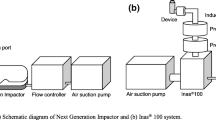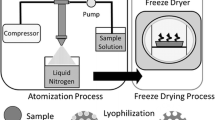Abstract
Purpose. To study the dispersion performance of non-porous corrugated particles, with a focus on the effect of particle surface morphology on aerosolization of bovine serum albumin (BSA) powders.
Methods. The solid-state characteristics of the spray-dried BSA powders, one consisting of smooth spherical particles and another corrugated particles, were characterized by laser diffraction, X-ray powder diffraction, scanning electron microscopy, confocal microscopy, thermogravimetric analysis, surface area analyzer, and buoyancy method. The powders were dispersed using the Rotahaler® and the Dinkihaler® coupled to a four-stage liquid impinger operating at 30 to 120 L/min. Fine particle fraction (FPF) was expressed as the wt. % of BSA particles of size ≤5 μm collected from the liquid impinger.
Results. Apart from the morphology and morphology-related properties (specific surface area, envelope density), the corrugated particles and spherical particles of BSA had very similar solid-state characteristics (particle size distribution, water content, true density, amorphous nature). Using the Dinkihaler®, the FPFs of the corrugated particles were 10-20 wt. % higher than those of the smooth particles. Similar FPF differences were found for the powders dispersed by the Rotahaler®, but the relative changes were larger. In addition, the differences were inversely proportional to the air flows (17.3% at 30 L/min, 25.2% at 60 L/min, 13.8% at 90, 8.5% at 120 L/min). Depending on the inhaler, capsule and device retention and impaction loss at the impinger throat were lower for the corrugated particles.
Conclusions. Enhanced aerosol performance of powders can be obtained by surface modification of the particles. The surface asperities of the corrugated particles could lower the true area of contact between the particles, and thus reduce the powder cohesiveness. A distinct advantage of using corrugated particles is that the inhaler choice and air flow become less critical for these particles.
Similar content being viewed by others
REFERENCES
D. Ganderton and N. M. Kassem. Dry powder inhaler. In D. Ganderton, T. Jones (eds.), Advances in Pharmaceutical Sciences, Academic Press, London, 1992. pp. 165-191.
H.-K. Chan and I. Gonda. Respirable form of crystals of cromoglycic acid. J. Pharm. Sci. 78:176-180 (1989).
K. A. Fults, I. F. Miller, and A. J. Hickey. Effect of particle morphology on emitted dose of fatty acid-treated disodium cromoglycate powder aerosols. Pharm. Dev. Technol. 2:67-79 (1997).
Y.-F. Maa, H. R. Costantino, P.-A. Nguyen, and C. C. Hsu. The effect of operating and formulation variables on the morphology of spray-dried protein particles. Pharm. Dev. Technol. 2:213-223 (1997).
Y.-F. Maa, P.-A. Nguyen, T. Sweeney, S. J. Shire, and C. C. Hsu. Protein inhalation powders: Spray drying vs spray freeze drying. Pharm. Res. 16:249-254 (1999).
R. Vanbever, J. Mintzes, J. Wan, J. Nice, D. Chen, R. Batycky, R. Langer, and D. A. Edwards. Formulation and physical characterization of large porous particles for inhalation. Pharm. Res. 16:1735-1742 (1999).
P. Lucas, K. Anderson, U. J. Potter, and J. N. Staniforth. Enhancement of small particle size dry powder aerosol formulations using an ultra low density additive. Pharm. Res. 16:1643-1647 (1999).
T. Tarara, J. Weers, and L. Dellamary. Engineered powders for inhalation. In R. N. Dalby, P. R. Byron, S. J. Farr, J. Peart (eds), Respiratory Drug Delivery VII Vol. 2, Serentec Press, Raleigh, North Carolina. 2000, pp. 413-416.
A. Ben-Jebria, D. H. Chen, M. L. Eskew, R. Vanbever, R. Langer, and D. A. Edwards. Large porous particles for sustained protection from carbachol-induced bronchoconstriction in guinea pigs. Pharm. Res. 16:555-561 (1999).
D. A. Edwards, J. Hanes, G. Caponetti, J. Hrkach, A. Ben-Jebria, M. L. Eskew, J. Mintzes, D. Deaver, N. Lotan, and R. Langer. Large porous particles for pulmonary drug delivery. Science 276: 1868-1871 (1997).
N. Y. K. Chew and H.-K. Chan. Influence of particle size, air flow and inhaler device on the dispersion of mannitol powders as aerosols. Pharm. Res. 16:1098-1103 (1999).
N. Y. K. Chew, D. F. Bagster, and H.-K. Chan. Effect of particle size, air flow and inhaler device on the aerosolisation of disodium cromoglycate powders. Int. J. Pharm. 206:75-83 (2000).
H. K. Chan, A. Clark, I. Gonda, M. Mumenthaler, and C. Hsu. Spray dried powders and powder blends of recombinant human deoxyribonuclease (rhDNase) for aerosol delivery. Pharm. Res. 14:431-437 (1997).
I. Gonda. Phyisco-chemical principles in aerosol delivery, In D. J. A. Crommelin and K. K. Midha (eds.), Topics in Pharmaceutical Sciences 1991, Chapter 7, Medpharm Sci. Publ., Stuttgart, 1992, pp. 95-115.
A. H. De Boer, D. Gjaltema, and P. Hagedoorn. Inhalation characteristics and their effects on in vitro drug delivery from dry powder inhalers. Part 2: Effect of peak flow rate (PIFR) and inspiration time on the in vitro drug release from three different types of commercial dry powder inhalers. Int. J. Pharm. 138:45-56 (1996).
K. J. Smith, H.-K. Chan, and K. F. Brown. Influence of flow rate on aerosol particle size distributions from pressurized and breath-actuated inhalers. J. Aerosol. Med. 11:231-245 (1998).
A. L. Adjei and P. K. Gupta. Dry-powder inhalation aerosols. In A. L. Adjei A. L., P. K. Gupta (eds.), Inhalation Delivery of Therapeutic Peptides and Proteins. M. Dekker, New York. 1997. pp. 625-665.
J. Wang, A. Ben-Jebria, and D. A. Edwards. Inhalation of estradiol for sustained system delivery. J. Aerosol Med. 12:27-36 (1999).
D. L. French, D. A. Edwards, and R. W. Niven. The influence of formulation on emission, deaggregation and deposition of dry powders for inhalation. J. Aerosol Sci. 27:769-783 (1996).
C. J. R. Sheppard and D. M. Shotton. Confocal Laser Scanning Microscopy. BIOS Scientific Publishers Ltd., Oxford, United Kingdom. 1997.
J. D. Brain and J. D. Blanchad. Mechanisms of particle deposition and clearance. In F. Moren, M. B. Dolovich, M. T. New-house, S. P. Newman (eds.), Aerosols in Medicine, Principles, Diagnosis and Therapy, Elsevier Science Publishers, New York, 1993 pp. 117-156.
M. B. Ranade. Adhesion and removal of fine particles on surfaces. Aerosol. Sci. Tech. 7:161-176 (1987).
Author information
Authors and Affiliations
Rights and permissions
About this article
Cite this article
Chew, N.Y.K., Chan, HK. Use of Solid Corrugated Particles to Enhance Powder Aerosol Performance. Pharm Res 18, 1570–1577 (2001). https://doi.org/10.1023/A:1013082531394
Issue Date:
DOI: https://doi.org/10.1023/A:1013082531394




